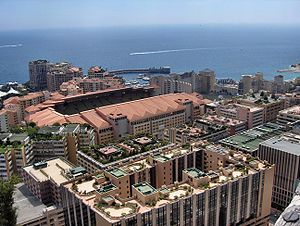Stadio Aureà
 | |
 | |
| Address | Aviènd d'Ercole 1 Teràçio TE0454 |
|---|---|
| Public transit | VM |
| Parking | 150 underground, VIP only |
| Owner | State of Montecara |
| Operator | Xógi Naxonàli s.a.i. |
| Capacity | 33,205 |
| Record attendance | 35,703 7 May 1994 The Easy Riders concert |
| Field size | 105 × 68 m |
| Surface | Hybrid grass |
| Construction | |
| Built | 1926 |
| Renovated | 2012 |
| Rebuilt | 1989 |
| Tenants | |
| Montecara national football team SB Montecara | |
Stadio Aureà, known for branding purposes as Aeracara Stadio Aureà, is the national stadium of Montecara. It is home to professional football team SB Montecara and the Montecaran men's and women's national football teams. In addition to its football field, the stadium includes facilities for track and field competitions. The stadium is also used as a venue for concerts and other live events.
The current structure dates from 1989, when the original stadium from 1926 was rebuilt. A renovation undertaken in 2012 modernized the stadium, particularly the media and communications facilities.
History
Original structure
The original stadium was built by the Gaullican imperial administration in 1926. The National Functionalist government of the time put a great emphasis on sports and physical development as well as leisure activities for the masses, and when it undertook a stadium building boom in the 1920s Montecara was included on its list of building priorities. Construction was done under the auspices of the Corps Récréatif Ouvrier (CRO, "Workers' Recreation Corps"), the state-run sporting organization, which also operated the stadium once it was complete. The CRO had a monopoly on league sports and founded SB Montecara to play in the new stadium; the club remains the main tenant.
The site chosen was on gravelly landfill along the southern coast, with a view of the Solarian Sea. The stadium had a simple design consisting of tiered seating along one side of the field and a sunshade over the center section. To give the stadium the flexibility to host other sports, the design included a permenant track and places for field events.
1989 rebuild
By the 1980s it was abundantly clear that the stadium was inadequate by modern standards. After considering several options, including razing the structure and building a new stadium elsewhere, the state decided to totally rebuild the stadium while incorporating as much of the historic structure as possible. The original stone tiered seating structure was preserved, but nearly everything else about the stadium was new. Builders added modern stadium amenities which had been absent before like training and administrative facilities, modern dressing rooms, a team store, underground parking, concession stands, private boxes, press facilities, and better floodlighting. The new stadium also boasted state-of-the-art broadcasting studios and medical facilities. The playing surface was regraded and reseeded to improve drainage and eliminate bare spots. A new roof covered all seating areas, and the street-facing exterior was rebuilt to include ground-floor retail on all sides.
2012 renovation
An extensive renovation undertaken in 2012 improved the press facilities, wired and wireless communications infrastructure, elevators and escalators, and electronic ticketing and turnstile system, and included a general update of interior design elements. The grass field was replaced with a hybrid surface reinforced with synthetic fibers.
Football
Opening match
Other sports
The stadium includes a running track built to Invictus Games specifications and facilities for field events. It has also been host to competitions in equestrian events, archery, and shooting.
Concerts
The stadium has hosted dozens of musical performances beginning with The Easy Riders in 1968. Some of the most notable include:
- The Easy Riders, 1968, 1994
- Jupiter Starling, 1987
- Regent Sound, 1993
- Brünette, 1979, 2008
- Souzo Riot, 1991
- Sanctuary, 1997
- The Morning Sun Club, 2011
- Mardy Bums, 2021
- Emme ZMX, 2018
- Violaine Rousseau, 2022
Access
Public transit is provided by VM.
